 Image search results - "bon" Image search results - "bon" |

Yasukuni Shrine during the Mitama Matsuri before dark.
|
|

Yasukuni Shrine's main torii during Mitama Matsuri
|
|

Promenade to the shrine
|
|

Spotlights create a silhouette of the statue of Omura Masujiro (1824-1869) 大村益次郎, founder of Japan's modern army.
|
|

A bon dance around the base of the statue.
|
|
|
|

Spotlights hit the torii.
|
|

Bonsai plum treesI bought one of these once and the flowers smelled good before they withred away. The tree also died soon afterward.
|
|

At night, 30,000 lanterns light up. A real summer spectacle.
|
|

The lanterns are lit by lightbulbs, not candles.
|
|
|

Tanabata streamers festoon the gate.
|
|
|

At 6:30 pm, a mikoshi portable shrine was paraded along the promenade.
|
|
|
|
|
|
|
|

One of the giant spotlights used to accent the mikoshi, torii, and night sky.
|
|
|

After the mikoshi, the Nebuta float and haneto dancers make an appearance.
|
|
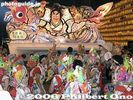
Rassera-rassera!
|
|

Nebuta float and haneto dancers. Also see the video at YouTube.Mitama Mtasuri at Yasukuni Shrine.
|
|

Awa Odori dancers also performed.
|
|
|
|

Nebuta close-up
|
|

Nice to see a bit of Aomori in Tokyo.
|
|

After the Nebuta made its way in front of the shrine, a short prayer was held.
|
|
|

The shrine
|
|

The Nebuta then went back to the promenade.
|
|
|

Lanterns
|
|
|
|

The lanterns are written with the names of the donors.
|
|
|

Stage entertainment is also provided during the festival.
|
|
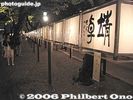
The bigger lanterns have artwork. Some of them were done by celebrities.
|
|

Path to the Yushukan war museum.
|
|

Yushukan war museum
|
|

Next to the museum was a display of different lanterns, including a Neputa (left) and Nebuta (right).
|
|
|
|
|

Neputa is from Hirosaki, Aomori Pref.
|
|

Neputa closeup
|
|
|
|
|

Food stall
|
|
|
|
|

Eisa dancing is performed on the streets at night in every village on Okinawa during the three days of Obon, late in August. Here a young lady dressed in traditional Okinawan yukata (an informal kimono) marches while waving Rising Sun paper fans.Photo copyright 2009 Michael Lynch.
|
|

During each brief pause in the Eisa music, the men make a loud whistling noise that is distinctly Okinawan. All photos copyright 2009 Michael Lynch.Photo copyright 2009 Michael Lynch.
|
|

The Eisa dancers are all unmarried men and women between 20 and 30 years of age. The small handheld drums, known as Panraku, have the traditional symbol of Okinawa painted in gold on them.Photo copyright 2009 Michael Lynch.
|
|

The Buffoon, Clown, or Town Drunk is a man who zig-zags through the line of dancers to the beat of his own drum, entertaining everyone and chasing evil spirits away.Photo copyright 2009 Michael Lynch.
|
|

Here the Buffoon (called Gajangani) can be seen going in the opposite direction of all the other male dancers and waving a banana leaf. Some clowns carry bottles of sake and try to get bystanders to drink with them.Photo copyright 2009 Michael Lynch.
|
|

Each team of Eisa dancers has its own band riding in the back of a straw roof-covered truck. Sanshin (3 stringed instrument) players sing and play Okinawan folk music accompanied by CD’s blasted over a loudspeaker system. Photo copyright 2009 Michael Lynch.
|
|
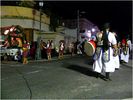
Different color yukata and uniforms of the dancers are worn, depending on which district or village they represent.Photo copyright 2009 Michael Lynch.
|
|

The large banner or flag carried on a bamboo pole is known as Hatagashisa and also represents a village or district. Each has their own unique design and the team takes pride in displaying it as a symbol of strength and prosperity for their hometown.Photo copyright 2009 Michael Lynch.
|
|
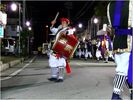
The large drum used for marching is slightly smaller than a Taiko and is called an Odaiko drum. The drummer in this photo is the only female player of this team to play such a large drum and she smiles and beats it enthusiastically.Photo copyright 2009 Michael Lynch.
|
|
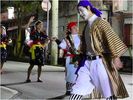
The brown and beige garment worn by this Buffoon is hand woven clothing called Bashofu. It is made from the fiber of banana plants. There may be two or three of these characters with each Eisa group skipping and weaving through the dancers as if they...The brown and beige garment worn by this Buffoon is hand woven clothing called Bashofu. It is made from the fiber of banana plants. There may be two or three of these characters with each Eisa group skipping and weaving through the dancers as if they weren’t there. Photo copyright 2009 Michael Lynch.
|
|

Here a group of men reach into a cooler for some refreshments while on a quick break from dancing. They will pile on trucks and move to the next location, performing Eisa dances well past midnight at every street, in every village for miles around.Photo copyright 2009 Michael Lynch.
|
|
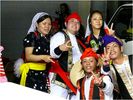
For their parting shot, these Eisa dancers couldn’t resist flashing the Peace sign along with their smiles for the camera. Photo copyright 2009 Michael Lynch.
|
|

On Aug. 23 and 24, Samegai's Jizo-do temple holds the annual Jizo-bon festival at night. The Nakasendo Road has food stalls and displays of paper mache figures. 地蔵盆
|
|

Jizo-bon is held along the Nakasendo road with various displays of paper mache figures made by local school children.
|
|
|
|
|
|

Jizo-bon in Samegai, Maibara.
|
|
|

People line up at Jizo-do temple to pray to Jizo.
|
|

Jizo altar at Jizo-do temple in Samegai, Maibara.
|
|

Jizo statues during Jizo-bon.
|
|
|

Figures at Isame-no-Kiyomizu spring during Jizo-bon festival.
|
|
|
|

Fortune-telling octopus.
|
|
|
|

Some displays move.
|
|

Hiroshige's print of Samegai-juku in his Kisokaido series.
|
|

Exhibition space in Mizunoeki
|
|

Exhibition in Mizunoeki
|
|

Exhibition in Mizunoeki
|
|

Every Jan.-Mar., the Keiunkan (慶雲館), a former guesthouse originally built in 1887 to accommodate Emperor Meiji when he visited Nagahama, holds the Nagahama Bonbaiten exhibition (Nagahama Bonsai Plum Blossom Trees).
|
|

Keiunkan admission to the Nagahama Bonsai Plum Blossom Tree exhibition.
|
|

Entrance hall
|
|

Plum tree bonsai greets visitors. 長浜盆梅展
|
|

Every Jan.-Mar., the Keiunkan holds the Nagahama Bonbaiten exhibition of plum tree bonsai.
|
|

Nagahama Bonbaiten exhibition of plum tree bonsai at Keiunkan. 長浜盆梅展
|
|

Plum tree blossom bonsai with red plum blossoms
|
|

Plum tree blossom bonsai with white plum blossoms.
|
|

Plum blossom bonsai when it's too early.
|
|
|
|
|
|
|

不老(ふろう) 八重紅色
|
|
|
|
|
|
|
|
|
|
|

清音(せいいん)
|
|
|
|
|

清幽(せいゆう)
|
|
|
|
|
|
|
|
|
|
|

Potted ume bonsai trees.
|
|
|
|
|

2nd floor of Keiunkan
|
|

After you exit, there's some bonsai plum trees for sale.
|
|

The 37th Otsuka Awa Odori was held on Aug. 26, 2009 (Wed.) in the middle of the week from about 5 pm to 9 pm. They paraded on the main road in front of the south side of JR Otsuka Station on the Yamanote Line in Tokyo.
|
|

Both sides of the road were almost totally covered with vinyl mats by people reserving a spot to watch the dance. The festival seemed to be mainly for the local folks, not for tourists from outside who could not get close to the roadside.
|
|

So it was not a good situation for taking pictures. The dance route was short, maybe only 300 meters. They danced on only one road. That's why it was quite crowded.
|
|

Sugamokko-ren すがもっ子連
|
|
|

They are from Toshimagaoka Joshi Gakuen, a private girls' school. 豊島岡女子学園 桃李連
|
|

Otsuka Awa Odori, Tokyo
|
|
|
|
|
|
|

Otsuka Awa Odori paper lanterns
|
|

Seiwa-ren 盛和連
|
|
|
|
|
|

Seiwa-ren 盛和連
|
|
|
|
|
|

Sun Mall Otsuka Ekimae-ren. サンモール大塚駅前連
|
|
|
|
|

Sun Mall Otsuka Ekimae-ren. サンモール大塚駅前連
|
|

Sanwa-ren 三和蓮
|
|
|
|

Otsuka Awa Odori
|
|

Otsuka Awa Odori
|
|

Shoko-ren 商興連
|
|
|
|

Shoko-ren 商興連
|
|
|
|
|
|
|

Otsuka Awa Odori
|
|
|
|
|
|
|
|
|
|
|
|

Kumegawa-ren, from Higashi-Murayama (not Otsuka) 久米川連
|
|
|
|
|

Kumegawa-ren, from Higashi-Murayama (not Otsuka) 久米川連
|
|

Keyaki-ren from neighboring Itabashi Ward. 板橋区役所 けやき連
|
|

Keyaki-ren from neighboring Itabashi Ward. 板橋区役所 けやき連
|
|

Shinsui-ren 新粋連
|
|

Shinsui-ren 新粋連
|
|

Toshima Kuyakusho-ren (Ward Office) 豊島区役所連
|
|

They work at the Toshima Ward Office (City Hall).
|
|
|

Toshima Kuyakusho-ren (Ward Office) 豊島区役所連
|
|
|
|
|

Toshima Kuyakusho-ren (Ward Office), Otsuka Awa Odori 豊島区役所連
|
|
|

Tenkei-ren from Shinjuku. 天恵連
|
|
|
|

Sugamo-ren すがも連
|
|

Sugamo is a neighboring train station, also in Toshima Ward.
|
|
|

Otsuka Awa Odori poster for 2009. The dance is held on only one evening.
|
|
|

On the day of the bonfire festival, they have shuttle buses going between the train station and Tarobogu Shrine. Highly recommend taking the bus.
|
|

Get off the bus and here we are. A large clearing (shrine's parking lot) surrounded by a large crowd.
|
|

Pile to be burned for the bonfire.
|
|
|
|
|
|
|
|

Lighting the pile.
|
|
|

The bonfire is used to burn about 100,000 goma prayer tablets collected from all over Japan. Tarobogu Shrine, Higashi-Omi, Shiga.
|
|

The fire's spiritual force supposed to ward off evil, accidents, and sickness and cleanse you. Tarobogu Shrine, Higashi-Omi, Shiga.
|
|

Kind of unique festival because it combines Shinto and Buddhist practices.
|
|
|
|
|
|

The smoke can get very thick. People with a lung condition or clothing sensitive to smoke should not see this.
|
|

Fanning the fire.
|
|
|
|
|
|
|
|
|

Mountain ascetic priests chanting.
|
|

Mountain ascetic priests chanting.
|
|

Mountain ascetic priests chanting.
|
|
|
|
|
|
|

Priests throw wooden goma prayer tablets (written with people's wishes) into the fire.
|
|

Priests throw wooden goma prayer tablets (written with people's wishes) into the fire.
|
|

Priests throw wooden goma prayer tablets (written with people's wishes) into the fire.
|
|

Priests throw wooden goma prayer tablets (written with people's wishes) into the fire. Tarobogu Shrine, Higashi-Omi, Shiga.
|
|
|
|
|

After the smoke is gone...
|
|
|
|
|
|
|

Toward the end, there is fire-walking on the hot embers. 火渡り
|
|

Toward the end, there is fire-walking on the hot embers.
|
|
|

Prayer before the fire walk.
|
|

I did it as well, wasn't so hot.
|
|
|
|

Cool your feet in salt.
|
|
|
|

The hardest part of the fire walk was putting your shoes back on. No benches to sit on.
|
|
|

Sacred staff for the fire walk.
|
|
|
|
|

Fire walk pit still smoking.
|
|

Glad to take the shuttle bus back to the trasin station.
|
|

Held during the Bon season on Aug. 16, toro nagashi is candle-lit paper lanterns floated on the ocean as a Buddhist offering to the spirits of the deceased.Tsuruga holds its mass toro nagashi (6,000 lanterns) on its famous Kehi no Matsubara beach at 6:30 pm, and then shoots off a grand fireworks display. My video of Toro Nagashi and brilliant marine fireworks taken on Aug. 16, 2017.
|
|

Line to board the free shuttle bus from Tsuruga Station to Kehi no Matsubara Beach.The waiting time was minimal since buses kept coming often. They chartered buses from numerous bus companies.
|
|

15-min. walk from the bus stop to the beach. People everywhere.
|
|

Crowd on Kehi no Matsubara Beach
|
|
|
|
|